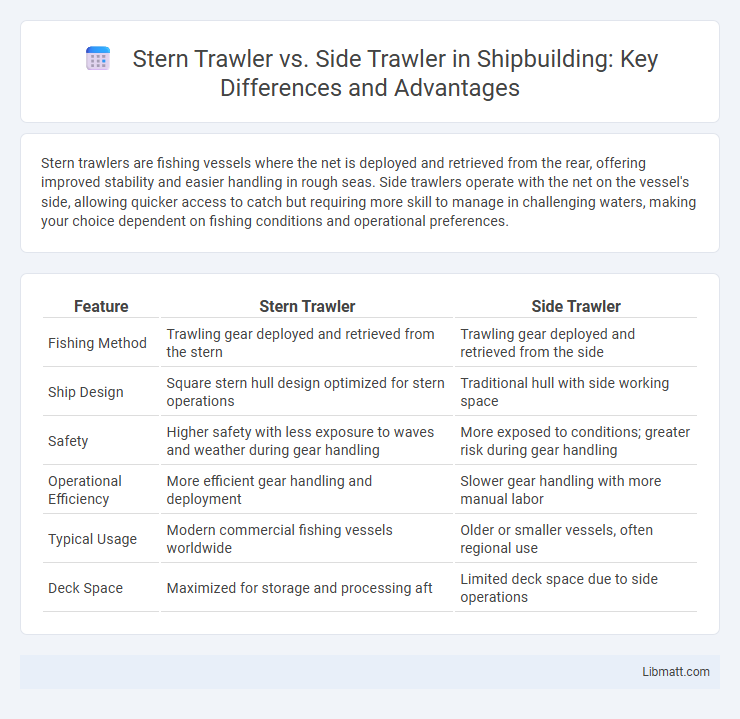Stern trawlers are fishing vessels where the net is deployed and retrieved from the rear, offering improved stability and easier handling in rough seas. Side trawlers operate with the net on the vessel's side, allowing quicker access to catch but requiring more skill to manage in challenging waters, making your choice dependent on fishing conditions and operational preferences.
Table of Comparison
| Feature | Stern Trawler | Side Trawler |
|---|---|---|
| Fishing Method | Trawling gear deployed and retrieved from the stern | Trawling gear deployed and retrieved from the side |
| Ship Design | Square stern hull design optimized for stern operations | Traditional hull with side working space |
| Safety | Higher safety with less exposure to waves and weather during gear handling | More exposed to conditions; greater risk during gear handling |
| Operational Efficiency | More efficient gear handling and deployment | Slower gear handling with more manual labor |
| Typical Usage | Modern commercial fishing vessels worldwide | Older or smaller vessels, often regional use |
| Deck Space | Maximized for storage and processing aft | Limited deck space due to side operations |
Introduction to Stern Trawlers and Side Trawlers
Stern trawlers are fishing vessels designed with a working deck at the stern, enabling efficient hauling and processing of large trawl nets directly onto the rear deck. Side trawlers operate by deploying and retrieving nets over the vessel's side, which requires specialized winches and open side decks for handling the fishing gear. Both types differ in deck layout and trawling method, influencing their operational efficiency and suitability for various fishing conditions.
Historical Development of Trawling Methods
Stern trawlers revolutionized commercial fishing in the mid-20th century by enabling larger nets to be deployed directly from the stern, enhancing efficiency and safety compared to traditional side trawlers. Side trawlers, prominent in the early 1900s, featured nets deployed over the vessel's side, limiting vessel size and catch capacity. Understanding the historical development of these trawling methods highlights how technological advancements have optimized your fishing operations for improved yield and sustainability.
Design and Structure Differences
Stern trawlers feature a design where the fishing net is deployed and retrieved over the stern, allowing for a more streamlined deck layout and improved handling of heavy gear. Side trawlers have their net handling equipment positioned on the vessel's side, which can limit deck space and complicate operations in rough seas. The structural difference significantly impacts stability, with stern trawlers offering greater efficiency and safety in harsh marine environments.
Gear Deployment: Stern vs. Side Techniques
Stern trawlers deploy fishing gear from the rear of the vessel, enabling efficient handling of large nets and minimizing interference with the ship's movement. Side trawlers operate by deploying nets from the vessel's side, allowing for simultaneous fishing alongside the ship but requiring more complex maneuvering to avoid gear entanglement. The stern deployment system provides greater control and safety during trawling operations compared to the traditional side trawling technique.
Operational Efficiency and Crew Safety
Stern trawlers offer superior operational efficiency due to advanced hydraulic systems that streamline net deployment and recovery, reducing downtime and fuel consumption compared to side trawlers. The design of stern trawlers enhances crew safety by positioning the working deck away from the vessel's side, minimizing exposure to hazards during fishing operations. Side trawlers, while traditional, pose higher risks with deck operations near the waterline, increasing the chance of accidents and limiting efficiency in harsh sea conditions.
Catch Capacity and Target Species
Stern trawlers generally offer larger catch capacity due to their robust design and ability to tow heavier nets, making them efficient for harvesting deep-sea species such as cod, haddock, and pollock. Side trawlers typically have smaller catch capacity and are better suited for coastal fishing, targeting species like shrimp, flatfish, and smaller pelagic fish. Your choice between stern and side trawlers should depend on the targeted species and required volume of the catch.
Technological Innovations in Trawling
Stern trawlers incorporate advanced hydraulic systems and automated net handling technology, enhancing fishing efficiency and reducing manual labor compared to side trawlers. Side trawlers rely on traditional winch mechanisms, which limit the speed and precision of net deployment and retrieval. Your choice of vessel influences the integration of cutting-edge sonar and navigation systems that optimize fish detection and sustainable fishing practices.
Environmental Impact: Bycatch and Seafloor Disturbance
Stern trawlers typically cause greater seafloor disturbance due to their methods of deploying and retrieving trawl nets from the stern, often dragging heavier gear across benthic habitats. Side trawlers may reduce bycatch rates by allowing more selective net deployment and retrieval, minimizing unintentional capture of non-target species. Both trawler types contribute to ecosystem disruption, but the design and operation differences influence their relative environmental impact on seafloor habitats and bycatch levels.
Economic Considerations for Fishermen
Stern trawlers typically offer greater economic efficiency due to larger hauling capacity and faster processing times, enabling higher catch volumes per trip compared to side trawlers. Side trawlers, while generally more cost-effective for smaller-scale operations, often incur higher labor costs and slower deck handling, impacting overall profitability. Investment in stern trawlers may demand higher initial capital but yields better long-term returns through enhanced fuel efficiency and reduced downtime.
Future Trends in Trawler Design and Usage
Future trends in trawler design emphasize sustainability, with stern trawlers adopting advanced fuel-efficient engines and eco-friendly fishing technologies to reduce environmental impact. Side trawlers are integrating automation and improved catch handling systems to increase operational efficiency and safety for crews. Both types are moving towards digital navigation and real-time data analytics for optimized fishing practices and resource management.
Stern trawler vs side trawler Infographic

 libmatt.com
libmatt.com